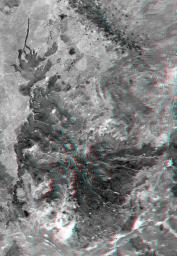This view of northern Patagonia, at Los Menucos, Argentina shows remnants of relatively young volcanoes built upon an eroded plain of much older and contorted volcanic, granitic, and sedimentary rocks. The large, dark "butterfly" pattern is a single volcano that has been deeply eroded. Large holes on the volcano's flanks indicate that they may have collapsed soon after eruption, as fluid molten rock drained out from under its cooled and solidified outer shell. At the upper left, a more recent eruption occurred and produced a small volcanic cone and a long stream of lava, which flowed down a gully. At the top of the image, volcanic intrusions permeated the older rocks resulting in a chain of small dark volcanic peaks.
At the top center of the image, two halves of a light ellipse pattern are offset from each other. This feature is an old igneous intrusion that has been split by a right-lateral fault. The apparent offset is about 6.6 kilometers (4 miles). Tonal and topographic discontinuities reveal the fault trace as it extends across the image to the lower left. However, young unbroken basalt flows show that the fault has not been active recently.
This anaglyph was generated by first draping a Landsat Thematic Mapper image over a topographic map from the Shuttle Radar Topography Mission, then producing the two differing perspectives, one for each eye. When viewed through special glasses, the result is a vertically exaggerated view of the Earth's surface in its full three dimensions. Anaglyph glasses cover the left eye with a red filter and the right eye with a blue filter.
Landsat satellites have provided visible light and infrared images of the Earth continuously since 1972. SRTM topographic data match the 30-meter (99-foot) spatial resolution of most Landsat images and provide a valuable complement for studying the historic and growing Landsat data archive. The Landsat 7 Thematic mapper image used here was provided to the SRTM project by the United States Geological Survey, Earth Resources Observation Systems (EROS) Data Center,Sioux Falls, South Dakota.
Elevation data used in this image was acquired by the Shuttle Radar Topography Mission (SRTM) aboard the Space Shuttle Endeavour, launched on February 11, 2000. SRTM used the same radar instrument that comprised the Spaceborne Imaging Radar-C/X-Band Synthetic Aperture Radar (SIR-C/X-SAR) that flew twice on the Space Shuttle Endeavour in 1994. SRTM was designed to collect three-dimensional measurements of the Earth's surface. To collect the 3-D data, engineers added a 60-meter-long (200-foot) mast, installed additional C-band and X-band antennas, and improved tracking and navigation devices. The mission is a cooperative project between the National Aeronautics and Space Administration (NASA), the National Imagery and Mapping Agency (NIMA) of the U.S. Department of Defense (DoD), and the German and Italian space agencies. It is managed by NASA's Jet Propulsion Laboratory, Pasadena, CA, for NASA's Earth Science Enterprise,Washington, DC.
Size: 121 kilometers (75 miles) x 83 kilometers (52 miles)
Location: 41 deg. South lat., 69 deg. West lon.
Orientation: North toward upper left
Image Data: Landsat band 4
Date Acquired: February 19, 2000 (SRTM), January 22, 2000 (Landsat)

 Planetary Data System
Planetary Data System












